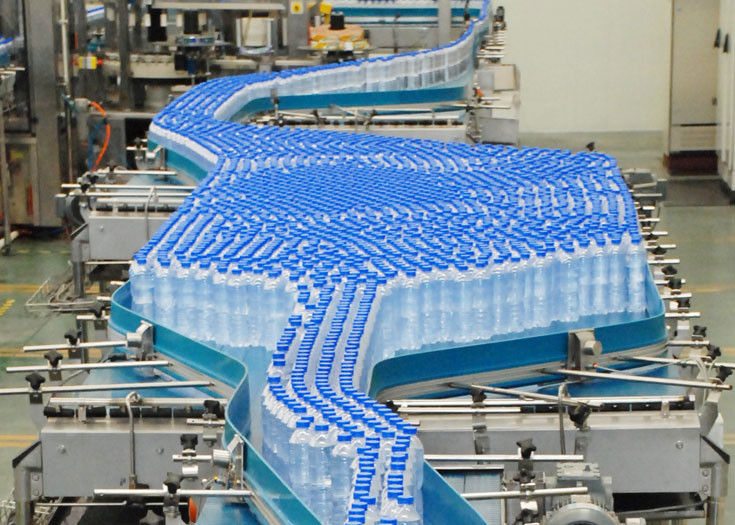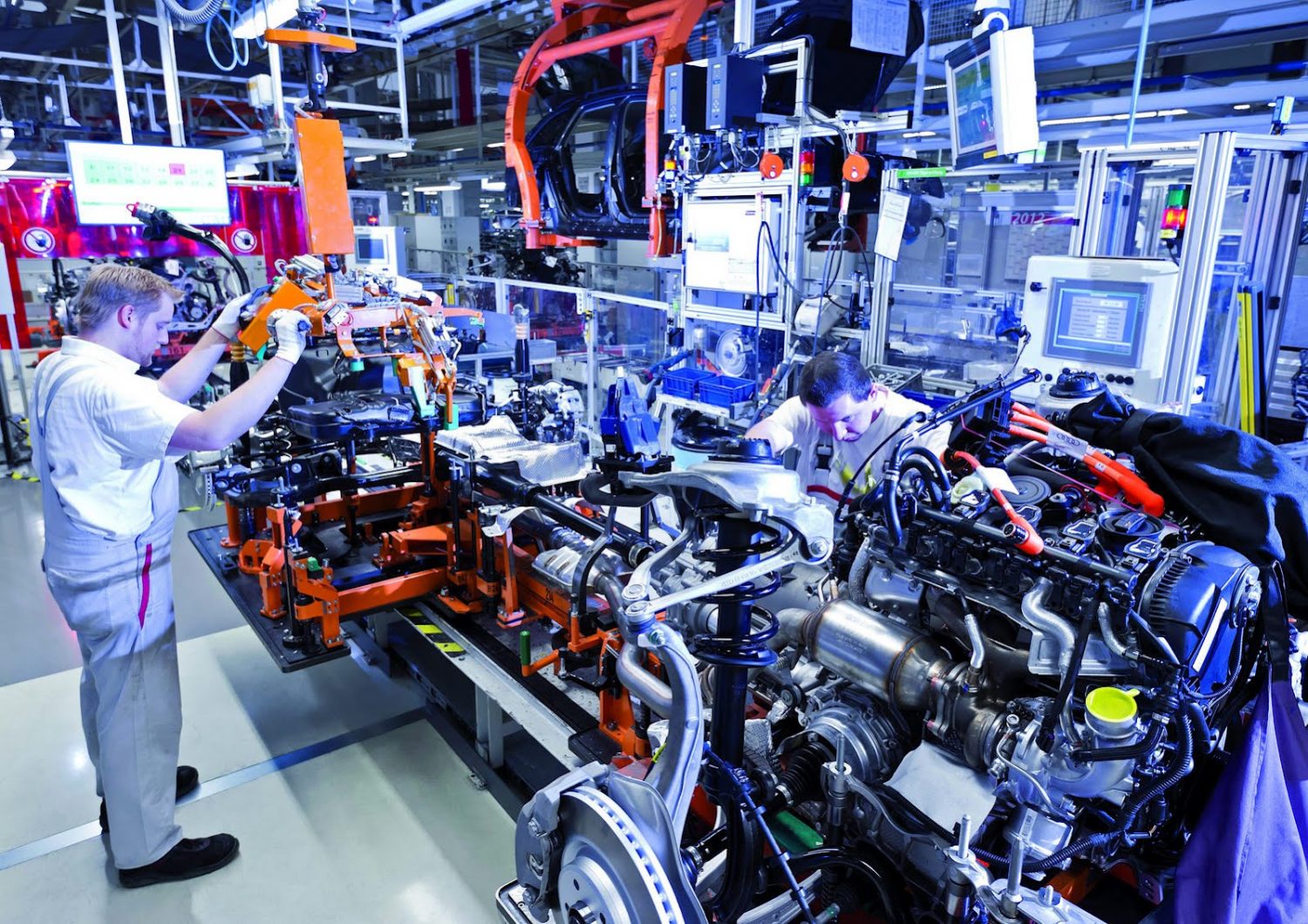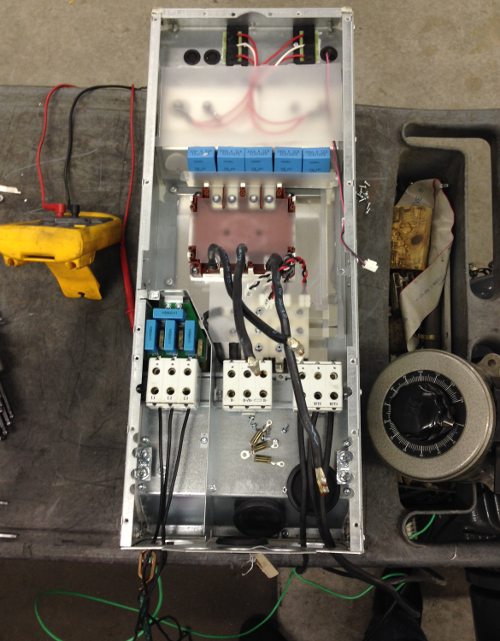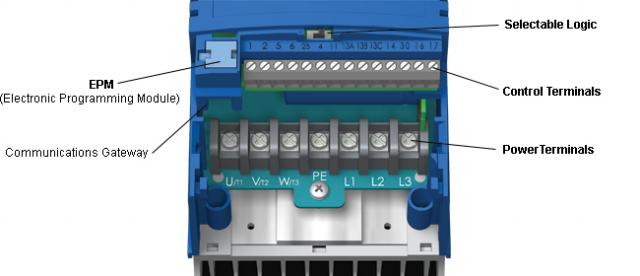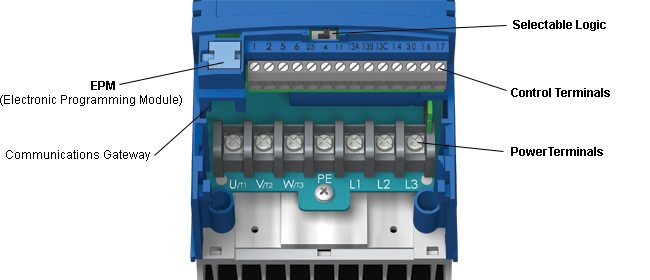Single Phase Power to Three Phase – Solutions For The Electric Motor User
/1 Comment/in HT VFDs/by Ryan ChamberlinWhen someoneneeds to runa three phaseelectric motor and only single phase power is available, they look for a solution. There are a couple options to go from single phase power to three phase. This article will discuss options available for going fromsingle phase power to three phase., pros and cons for each option, and,links to our website for products that will go from single phase power to three phase. There are two different methods to go from single phase power to three phase:
- Variable Frequency Drives (VFD’s)
- Rotary Phase Converters (RPC’s)
When going from single phase power to three phase, either avariable frequency drive or rotary phase converteris required. Variable frequency drivescome with a number of differentsingle phase input for three phase output options.Variable frequency drives that go from single phase power to three phase are availablein a wide range of voltage and power ratings: From120 Volt single phase input for 240 Volt three phase output, up to 1.5 horsepower; To208-240 Volt single phase input for 240 Volt three phase output, up to 3 horsepower.
Variable frequency drivescan also be derated to run three phase motors above 3 HP from single phase supply. Derating a VFDallows customers with 208-240 volt single phase power the ability to run 240 volt three phase equipment. Derated VFD’s are available up to 20 HP for 208-240 Volt single phase supply. Derating a VFD incorrectly for single phase supply can be easily avoided by contacting an experienced technician before purchasing equipment.
Rotary phase converters (RPCs) will change single phase power to three phase but RPC’s are heavy and use many moving parts. RPC’s are old technology but RPC’s will be around for years to come because some applications that go from single phase power to three phase cannot use a VFD; VFD’s can go from single phase to three phase forelectric motor driven applications; but RPC’s can go from single phase to three phase on applications with and without electric motors.
Single phase motors cannot be used on variable frequency drives. When customers with single phase motors wantto control the speed of their electric motor, the only option available is to replace the single phase motor with an equivalent three phase motor, and then apply a variable frequency drive to that three phase motor.For VFD and RPC repair and replacement quotes, contact Precision Electric.
How a VFD Works
/1 Comment/in FAQ VFDs, HT VFDs/by Ryan ChamberlinHow AVFD Works:A variable frequency drive is also known as a VFD, variable speed drive, adjustable speed drive, electronic motor controller, or an inverter. How a VFD Works: Every VFD is unique with its own component characteristics so how each VFD works is dependent upon components within the VFD. Most VFDs integrate a solid state electronics controller consisting of a bridge rectifier, a converter, and an inverter module.
Voltage-source inverter drives are the most common type of VFDs. These drives convert AC line input to AC inverter output.There are some applications that use common DC bus and solar applications. These type of drives are configured as DC to AC drives. The bridge rectifier converter for volts per hertz drives is configured for 3 phase AC electric motors. Volts per hertz drives usea capacitor to smooth out the converter DC output ripple and provides a solid input to the inverter.
This filtered DC voltage is converted to AC voltage output using the inverter’s active switching elements. VSI drives provide higher power factor and lower harmonic distortion (noise) than phase controlled current source inverters and load commutated inverters drives. The drive controller can also be configured as a phase converter having single-phase converter input and three-phase inverter output.Controller advances have allowed increased voltage and current ratings and switching frequency of solid-state power devices over the past 50 years. VFDs were first introduced in 1983, and the insulated gate bipolar transistor has in the past 20 years become the standard for VFDs as an inverter switching device.
In variable-torque applications using Volts per Hertz (V/Hz) drive control, AC motor specifications require that the voltage magnitude of the inverter’s output to the motor be adjusted to match the required load torque in a corresponding V/Hz relationship. For 460 VAC, 60 Hertz electric motors, this V/Hz relationship would be 460/60 = 7.67 V/Hz. While acceptable in a wide range of different applications, V/Hz control is sub-optimal in high performance applications. High performance applications requiring low speed control, demanding high torque, dynamic speed regulation, positioning, and reversing load demands, there are open loop VFDs and closed loop VFDs would be desired over V/Hz VFDs.
How a VFDWorks – Manufacturing
Many manufacturers will apply variable frequency drivesto rotating equipment to reduce amperage spikes upon start up of large electric motors. Choosing the right VFD for an application will benefit rotating equipment by providing less wear on the electric motors where applied. Adjusting the acceleration and deceleration time of electric motors can extend the lifespan of an electric motor. Variable frequency drives provide the ability to control the frequency of starting and stopping of an AC electric motor. This ability allows an AC electric motor to only operate when needed for the equipment its rotating, and electric motors have a longer lifespan if they are only running when they need to be.
Approximately one third of the worlds electrical energy is supplied by electric motors in fixed-speed centrifugal pump, fan, and air compressor applications. These fixed-speed applications hardly ever require the full load speed (RPM) of the electric motor in which theyre operating. By installing a VFD to these applications, electric motor speeds are reduced, and power costs can be reduced by 50% or more. Technology has allowed cost and physical size reduction of variable frequency drives, and has improved performance through advances in semiconductor switching devices, simulation, control techniques, and control hardware and software.
How a VFDWorks – Power Savings
The majority of variable frequency drives in the market today contain electronic circuitry that converts 60 Hertz Line power into direct current. The variable frequency drive converts this line power into a pulsed output voltage that duplicates varying alternating current to a desired frequency (speed). A properly applied VFD when paired with the correct electric motor will significantly reduce operating costs for manufacturers. This is particularly true for variable torque loads such as fans, blowers, and pumps. Blowers are often used with dampers to control air flow; these dampers may operate either manually or automatically. When dampers are closed, 50% of the electric motor current will drop to approximately 60% of full load nameplate current. By utilizing variable frequency drives in blower applications, the current draw of the motor will be reduced 30% for every 10% drop in speed. The same electric motor operating from an AC variable frequency drive at 50% speed, will draw approximately 20% of the full load current.
Please watch our YouTube Videoto learn more about how a VFD works.For VFD repair and replacement quotes, contact Precision Electric, Inc.
Variable Frequency Motor Drives
/in HT VFDs/by Ryan ChamberlinVariable frequency motor drives are also known as motor drives,variable frequency drives, VFD’s, variable speed drives, adjustable frequency drives, AFD’s, adjustable speed drives and ASD’s. Motordrives are solid state motor control systems used to regulatethe speed of alternating (AC) electric motors. Motordrives are mainly used to reduce energy consumption on electric motors for industrial manufacturers.
Motordrives operate as load controls within applications that may accomplish up to 50% reduction in energy costsby speed reduction on applications where the full speed (RPM) of the electric motor is not required. Motor drives are used in AC Servo Systems, Air Compressors, Conveyor Systems, Lathes, Mills, Plastic Extrusion, Slitter Lines, Food Processing, Waste Water Treatment Systems, Submersible Pumps, HVAC Fans and Blowers, and many more AC motor applications.
Many manufacturers apply motor drives withrotating equipment toreduce amperage spikes upon start up of large electric motors.Choosing the right motordrive for an application will benefit rotating equipment by providing less wear on the electric motor where applied. This is accomplished by adjusting the acceleration and deceleration time of electric motors. Adjusting the acceleration and deceleration time of an electric motor will greatly increase the lifespan of an electric motor. Motor drives provide the ability to control the frequency of starting and stopping of an AC electric motor.This ability provides a means by which an AC electric motor is only operating when needed for the equipment it’s rotating, and electric motors have a longer lifespan if they are not continuously operating when they don’t need to be.
Approximately one third of the world’s electrical energy is supplied by electric motors in fixed-speed centrifugal pump, fan, and air compressor applications. These fixed-speed applications hardly ever require the full load speed (RPM) of the electric motor they’re operating. By integrating motor drives to these applications, the motor speeds are reduced, and power costs can be reduced by 50% or more. Technology has reduced cost and physical size of motordrives, and has improved performance through advances in semiconductor switching devices, simulation, control techniques, and control hardware and software.
Power Savings With MotorDrives
The majority of motordrives in the market today contain electronic circuitry that converts 60 Hertz Line power into direct current. The motordrive converts this line power into a pulsed output voltage that duplicates varying alternating current to a desired frequency (speed).A properly applied motordrive when paired with an AC electric motor, will significantly reduce operating costs. This is particularly true for variable torque loads such asFans,Blowers, andPumps.Blowers, for example, are often used with dampers to control air flow. These dampers may operate either manually or automatically. When dampers are closed, 50% of the electric motor current will drop to approximately 60% of Full Load nameplate current. By utilizing a motor drive in this application, current draw in the motor will be reduced 30% for every 10% drop in speed. The same electric motor operating froma motor drive at 50% speed, will draw approximately 20% of the full load current.
Types Of Motor Drives
Volts Per Hertz motordrives are the most common type of drive and areknown as a V/Hz drives, or volts by hertz drives. V/Hz motordrives are used inapplications such as fans, pumps, air compressors, and other related applications wherehigh starting torque is not required. V/Hz drive applications typically do not require full torque when the AC motor is operating at less than the base speed (RPM) of the electric motor. V/Hz drives are the most inexpensive type of motor drive. V/Hz drives do not provide full motor torque at low RPM.
Open-Loop vector motordrives are also known as “sensorless vector” drives. Open loop vector drives adapted the name “sensorless vector” because they do not use an external encoder for speed feedback to the motor.Open loop vector drives are used in applications where high starting torque and full torque at low speed (RPM) is required. Open-Loop vector drives operating a motor a zero RPM should not be used on crane or hoist applications. Most open-loop vector drives are used on CNC machines, mixers, mills, lathes, and other applications where high starting torque or full torque at low RPM is needed.Open loop vector drives are usually more expensive than V/Hz inverterdrives.
Closed-Loop vector motor drives are used in applications where precise speed control (0.01%) is needed, or in applications where extensive programming is needed. Closed-Loop vector drives use an encoder on the motor to provide constant shaft position indication to the drive’s microprocessor. The encoder feedback allows the drive microprocessor to constantly control torque no matter how many RPM the motor is operating at. Closed-Loop vector motor drives are used to provide the motor to operate at full torque even at zero RPM. Closed-Loop vector drives are commonly used on hoist and crane applications because crane and hoist motors must produce full torque prior to it’s brake being released, or the load will drop and it will not be able to stop.
To learn more about motordrives or for motordriverepairs and replacement quotes, contact Precision Electric, Inc.
Inverter Repair
/in FAQ VFDs, FAQs, HT VFDs, Industrial/by Ryan ChamberlinMost inverterrepair can be prevented with routine maintenance. Inverter repair costs and lead times can also be reduced with routine maintenance. Inverterrepair can be expensive and also cost manufacturers production downtime while the inverter repair is in process.Most manufacturers stock spare inverter modulesto prevent production downtime in the event of an inverter failure.Components used forinverter modules are often cheaply made and prone to failure. Knowledgeable inverter repair shops should replace cheaply made components with high quality components during the inverter repair process. Using high quality components in an inverter repair ensures a higher chance of success and a longer lifespan during production.
Connections
Checkingconnections is a step many people miss or do incorrectly during the inverterrepair process. Heat cycles and mechanical vibration can lead to sub-standard connections, as can standard preventative maintenancepractices. Reusing torque screws is not a good Idea, and further tightening an already tight connection can ruin the connection.Bad connections eventually lead to arcing. Arcing at the inverterinput could result in nuisance over voltage faults, clearing of input fuses, or damage to protective components. Arcing at the inverteroutput could result in over-current faults or even damage to the power components.
Loose connections can cause erratic operation. Loose START/STOP signal wires can cause uncontrollable inverterstarting and stopping. A loose speed reference wire can cause the drive speed to fluctuate, resulting in scrap, machine damage, or personnel injury.
Conduct Diode and IGBT Tests
There are a number of methods to test the input and output power sections of an inverter, and this step is essential prior to applying power to the inverterunit. If for any reason there is a short on the input side or output side of the inverter, further damage can be caused to the unit if power is applied to it.
For this reason, Precision Electric uses meters to properly test the input and output power sections of the inverter prior to applying power to the actual unit. If a short is found, the unit can be disassembled and the cause of the short can be diagnosed and quoted for repair. If the repair is too costly, then a replacement is offeredto the customer.
Power Up Unit
If the input and output power sections test healthy during this step of the inverter repair process, Precision Electric will power the unit and perform amp reading and output frequency tests. Precision Electric prefers to slowly increase power voltage to the unit until the rated input voltage of the inverter is achieved.
Depending on whether or not the inverter provides a display will determine what further action(s) will be taken. If display is unavailable, dis-assembly and diagnosis of the internal power supply of the control section of the inverter is likely necessary to further evaluate cause of failure and establish costand lead time for the inverter repair.
Run A Motor
If the previous three tests have passed during the inverter repair process, then it is time to run a basic jog function of the inverter with a simple template program. Often when an inverter comes into our facility, we make sure to backup whatever program is currently stored in the inverterprior to inputting a template program and running a test procedure. This ensure we have a backup copy of the program.
The best method for backing up depends on the brand of drive, but after it has been backed up, we either reset the inverterto factory defaults through the keypad and recommission a basic start, stop and job application or closed loop if an encoder is involved. If the motor will not run, it will be necessary to checkthe output voltages and current ratings going to the motor to see if the inverteris functioning properly to rotate the motor.
Contact Customer
At this point we have determined the cause of failure, estimated lead time and costof the inverterrepair. If the inverter has tested good entirely, then further underlying issues are communicated with the customer. This is when Precision Electricwill gather application specific information from the customer to establish whether or not it may be some outside issue associated with the system including, but not limited to, PLC communications, faulty IO, bad wiring or even bad cabling. There is no single way to do this step, as it really depends on a wide variety of variables.
Send Service Tech
If the customer cannot establish failure on any other aspect of the machine and the inverterappears to test fine, then it may be necessary to send a field service technician on site to establish cause of failure. Field service technicians should betrained to troubleshoot any issue ranging from standard inverterrepair, to advanced robotics, PLCs and more. Field technicians should also be trained to establish cause of failure and come up with solutions as quick as possible.
Inverter repair should be taken with extreme caution. Inverterrepair should only be performed by technicians who have required training and experience to work with electrical equipment. Precision Electric strongly recommends to consult an expert in the field when repairing or installinginverterequipment.Many invertercontrollers have an internal DC bus that retains a charge after power has been cut to the drive, as a result, it does not mean it’s safe to work with. Technicians working with inverter repair must always take extra precautions to ensure proper safety measures are taken, or injury or even death may occur.
For inverterrepair and inverter replacement quotes, contact Precision Electric.
ABB ACS355 Emergency Stop
/in HT VFDs/by Ryan Chamberlin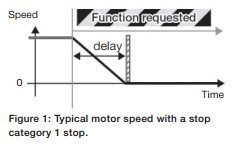 ABB ACS355 emergency stop is usedfor applications that require risk reduction from unexpected and hazardous movement. The aim to integrate drive-based safety functions is to createmachines that are safe to use. This safety function example is presented to install ABB ACS355 emergency stop but these same functions can be implemented with other ABB drives with few modifications. ACS355 machinery drives offer a safe torque off (STO) safety function as a standard integrated feature. STO eliminates the need to use contactors, which means that the drive is not disconnected from the power during safe stopping. This again enables fast restart of the drive and the machine. STO is also offered as standard in many ABB drive types for easy integration of functional safety.
ABB ACS355 emergency stop is usedfor applications that require risk reduction from unexpected and hazardous movement. The aim to integrate drive-based safety functions is to createmachines that are safe to use. This safety function example is presented to install ABB ACS355 emergency stop but these same functions can be implemented with other ABB drives with few modifications. ACS355 machinery drives offer a safe torque off (STO) safety function as a standard integrated feature. STO eliminates the need to use contactors, which means that the drive is not disconnected from the power during safe stopping. This again enables fast restart of the drive and the machine. STO is also offered as standard in many ABB drive types for easy integration of functional safety.
Overview of the Safety Function
ABB ACS355 emergency stop, stop category 1 (Figure 1), stops the drive with a controlled deceleration ramp before disabling the drives output to the motor. In this example, the deceleration ramp is time monitored. The safety function can be used in an application where a synchronized stop of multiple axes is required.
Design of the Safety Function
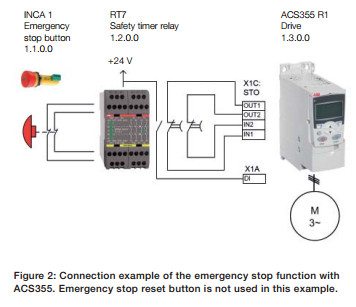 The design of theABB ACS355emergency stop consists of an emergency stop button as an activating switch, a safety timer relay as a logic unit and a safe torque off (STO) -circuit inside the ACS355 drive. The drive acts as an actuator to bring the motor into a nontorque state after the deceleration. See circuit diagram (Figure 2) for connection details.
The design of theABB ACS355emergency stop consists of an emergency stop button as an activating switch, a safety timer relay as a logic unit and a safe torque off (STO) -circuit inside the ACS355 drive. The drive acts as an actuator to bring the motor into a nontorque state after the deceleration. See circuit diagram (Figure 2) for connection details.
Operation of the safety function When the emergency stop button is pressed, the safety relay detects the button signal and opens its non-delayed contacts to inform the drive todecelerate. Simultaneously, the relays timer for the time delay contacts starts counting. After the time delay has elapsed, the contacts open, activating the STO function, which disables the drives power output to the motor. To continue drive operation after an emergency stop, the emergency stop button is released (pulled up), which causes the contacts of the relay to close. This deactivates the STO function. The drive is restarted by a separate start command. The drive is configured not to start automatically.
The safety relay is used to provide diagnostics for the emergency stop button wiring. The relay also enables the use of a separate reset button, if required (reset button is not shown in this example since it is not required by the standard). Ensuring the required safety performance The safety function has to fulfil the required safety performance determined by a risk assessment. ABBs Functional safety design tool (FSDT-01) is used to design the desired safety function.
This is carried out according to the Following Steps:
1. Evaluate the risks to establish target safety performance (SIL/PL level) for the safety function.
2. Design the safety function loop and verify the achieved performance (PL) or safety integrity level (SIL) for the safety function loop (according to EN ISO 13849-1 or EN/IEC 62061, respectively), utilizing the device safety data and the application specific characteristics.
3. Generate a report for the machine documentation. Report should contain all the calculation results as well as all assumptions made during the application design.
Safety function verification and validation In addition to the safety calculations for the achieved safety performance (SIL/PL), the safety function needs to be functionally verified as well. Finally the implemented safety function is validated against the risk assessment to ensure that the implemented safety function actually reduces the targeted risk.
General considerations Achieving machinery safety requires a systematic approach beyond the physical implementation of a safety function. The overall machinery safety generally covers the following areas:
- Planning for and managing functional safety during the life cycle of the machine
- Assuring compliance to local laws and requirements (such as the Machinery directive/CE marking)
- Assessing machine risks (analysis and evaluation)
- Planning the risk reduction and establishing safety requirements
- Designing the safety functions
- Implementing and verifying the safety functions
- Validating the safety functions
- Documenting the implemented functions and results of risk assessment, verification and validation
For more information concerning the ABBACS355 emergency stop function, visit the ABB Website.For ABB drive repair quotes or ABB drive replacement quotes, contact Precision Electric.
Preventive Maintenance VFD
/10 Comments/in FAQ VFDs, HT VFDs/by Ryan ChamberlinA VFD (variable frequency drive) controls the speed, torque and direction of an induction motor. A VFD takes fixed motor voltage and AC frequency and converts it to a variable voltage and frequency AC output. In very small VFDs, a single power pack unit may contain the converter and inverter modules. Preventive maintenance VFD programs preventmanufacturing downtime while maintaining optimal production performance.
Clean Environment– Preventive Maintenance VFD:
Most VFDs fall into the NEMA 1 category or NEMA 12 category. Drives that fall in the NEMA 1 category are susceptible to dust contamination. Dust on VFD hardware can cause a lack of airflow resulting in diminished performance from heat sink and circulating fans. Dust on an electronic device can cause malfunction or even failure. Dust absorbs moisture, which also contributes to failure. Periodically spraying air through the heat sink fan is a good PM measure. Discharging compressed air into a VFD is a viable option in some environments, but typical plant air contains oil and water. To use compressed air for cooling, you must use air that is oil-free and dry or you are likely to do more harm than good. A non-static generating spray or a reverse-operated ESD vacuum will reduce static build-up. Common plastics are prime generators of static electricity. The material in ESD vacuum cases and fans is a special, non-static generating plastic. These vacuums, and cans of non-static generating compressed air, are available through companies that specialize in static control equipment.
Control boards and other electronic components can be damaged when subjected to periodic moisture or water. Some VFD manufacturers include a type of condensation protection on certain product versions. If you operate a VFD all day every day, the normal radiant heat from the heat sink should prevent condensation. Unless the unit is in continuous operation, use a NEMA 12 enclosure and thermostatically controlled space heater where condensation is likely.
Keep Connections Tight – Preventive Maintenance VFD:
Checking connections is a step many people miss or do incorrectly, and the requirement applies even in clean rooms. Heat cycles and mechanical vibration can lead to sub-standard connections, as can standard PM practices. Reusing torque screws is not a good Idea, and further tightening an already tight connection can ruin the connection.
Bad connections eventually lead to arcing. Arcing at the VFD input could result in nuisance over voltage faults, clearing of input fuses, or damage to protective components. Arcing at the VFD output could result in over-current faults or even damage to the power components.
Loose connections can cause erratic operation. For example, a loose START/STOP signal wire can cause uncontrollable VFD starting and stopping. A loose speed reference wire can cause the drive speed to fluctuate, resulting in scrap, machine damage, or personnel injury.
Additional Considerations – Preventive Maintenance VFD:
- As part of a mechanical inspection procedure, don’t overlook internal VFD components.
- Check circulating fans for signs of bearing failure or foreign objects.
- Store spare VFDs in a clean, dry environment, with no condensation allowed.
- Power spare VFD’s every 6 months to keep the DC bus capacitors at their peak performance capability.
- Regularly monitor heat sink temperatures.
- Inspect DC bus capacitors for bulging and leakage. Either could be a sign of component stress or electrical misuse.
You wouldn’t place alaptop computer on the roof of a building or in direct sunlight, where temperatures could reach 115 degrees Fahrenheit or as low as -10 degrees Fahrenheit. A VFD, which is basically a computer with a power supply, needs the same consideration. Some VFD manufacturers advertise 200,000 hours-almost 23 years-of Mean Time between Failures (MTBF). Such impressive performance is easy to obtain, if you follow these simple procedures.
By integrating a preventive maintenance VFD program, you can ensure your drives provide minimal repair service while maximizing production.Always call certified variable frequency drive integrators or experienced technicians to perform preventive maintenance VFD services to prevent injury or death.
To learn more about preventive maintenance VFD programs or for VFD repair and replacement quotes, contact Precision Electric.
What Is A Variable Frequency Drive
/in HT VFDs, Industrial, News/by Ryan ChamberlinWhat is a variable frequency drive? Variable frequencydrives are also known as variable speed drives, VFD’s, adjustable speed drives, and inverters.
Variable frequency drives are solid state motor control systems designed to control the speed of an AC (alternating current) electric motor. Variable frequency drives operate as load controls within AC electric motor applications; and variable frequency drives can reduce energy costsup to 50% by speed reduction on electric motorswhere the full speed (RPM) of the electric motor is not required.Variable frequency drives are used in AC servo systems, air compressors, conveyor systems, lathes, mills, plastic extrusion, slitter lines, food processing, waste water treatment systems, submersible pumps, HVAC fans and blowers, and many more electric motor applications.
Many manufacturers apply AC variable frequency drives to rotating equipment because variable frequency drives reduce amperage spikes upon start up of large electric motors.Choosing the right AC variable frequency drive for an application will benefit rotating equipment by providing less wear on the electric motors where applied.Adjusting the acceleration and deceleration time of electric motors can extend the lifespan of an electric motor. AC variable frequency drives provide the ability to control the frequency of starting and stopping of an AC electric motor.This ability allowsan AC electric motor to only operate when needed for the equipment it’s rotating, and electric motors have a longer lifespan if they are not continuously operating when they don’t need to be.
Approximately one third of the world’s electrical energy is supplied by electric motors in fixed-speed centrifugal pump, fan, and air compressor applications. These fixed-speed applications hardly ever require the full load speed (RPM) of the electric motor in which they’re operating. By installing AC variable frequency drives to these applications, electric motor speeds are reduced, and power costs can be reduced by 50% or more. Technology has allowed cost and physical size reduction of AC variable frequency drives, and has improved performance through advances in semiconductor switching devices, simulation, control techniques, and control hardware and software.
Power Savings: What Is A Variable Frequency Drive
The majority of AC variable frequency drives in the market today contain electronic circuitry that converts 60 Hertz Line power into direct current. The variable frequency drive converts this line power into a pulsed output voltage that duplicates varying alternating current to a desired frequency (speed).A properly applied AC variable frequency drive when paired with an AC electric motor will significantly reduce operating costs for manufacturers. This is particularly true for variable torque loads such as fans, blowers, and pumps.Blowers are often used with dampers to control air flow; these dampers may operate either manually or automatically. When dampers are closed, 50% of the electric motor current will drop to approximately 60% of full load nameplate current. By utilizing an AC variable frequency drive in blower applications, the current draw of the motor will be reduced 30% for every 10% drop in speed. The same electric motor operating froman AC variable frequency drive at 50% speed, will draw approximately 20% of the full load current.
Example Application:
A 10 horsepower AC electric motor, rated 90% efficient, operating across the line without an AC variable frequency drive, with the dampers operating between 50 70%, for 2000 hours per year will require 11,996 KWH. If the KWH charge is $.08 per KWH, the cost to run this motor will be: $1,248.00 annually.The same 10 horsepower electric motor operating from an AC variable frequency drive, between 50 70% speed for 2000 hours per year will require 4,676 KWH. Operating cost at the same KWH rate will be: $432.00 per year. This represents a savings of $816.00 per year and should be enough to pay for the AC variable frequency drives investment and installation costs, within the first 12 months of operation.If any electric motor application operates more hours than in the above example, and/orthe KWH charge is higher, the savings will quickly compound.The energy saved on a utility bill from using a variable frequencydrive is often significant enough to pay for the variable speed frequencywithin a couple of months from installation date.Increasing and/or decreasing the start up time on an AC current electric motor via a variable frequencydrive can add years to the motor’s overall lifespan. Using a variable frequencydrive can also improve efficiency on production demands. Variable frequencydrives provide the ability to control the frequency of starting and stopping an AC electric motor.This ability provides a means by which an AC electric motor is only operating when needed. AC electric motors have a longer lifespan if they are not continuously operating when they do not need to be.
Types Of Drives: What Is A Variable Frequency Drive
Volts Per Hertz drives are the most common type of variable frequency drive and areknown as a V/Hz drives, or volts by hertz drives. V/Hz variable frequency drives are used inapplications such as fans, pumps, air compressors, and other related applications wherehigh starting torque is not required. V/Hz variable frequencydrive applications typically do not require full torque when the AC motor is operating at less than the base speed (RPM) of the electric motor. V/Hz variable frequencydrives are the most inexpensive type of variable frequencydrive. V/Hz variable frequencydrives do not provide full motor torque at low RPM.
Open-Loop vector drives are also known as “sensorless vector” variable frequencydrives. Open loop vector drives adapted the name “sensorless vector” because they do not use an external encoder for speed feedback to the motor.Open loop vector drives are used in applications where high starting torque and full torque at low speed (RPM) is required. Open-Loop vector drives operating a motor a zero RPM should not be used on crane or hoist applications. Most open-loop vector drives are used on CNC machines, mixers, mills, lathes, and other applications where high starting torque or full torque at low RPM is needed.Open loop vector drives are usually more expensive than a V/Hz variable speed drives.
Closed-Loop vector drives are used in applications where precise speed control (0.01%) is needed, or in applications where extensive programming is needed. Closed-Loop vector drives use an encoder on the motor to provide constant shaft position indication to the drive’s microprocessor. The encoder feedback allows the drive microprocessor to constantly control torque no matter how many RPM the motor is operating at. Closed-Loop vector drives are used to provide the motor to operate at full torque even at zero RPM. Closed-Loop vector drives are commonly used on hoist and crane applications because crane and hoist motors must produce full torque prior to it’s brake being released, or the load will drop and it will not be able to stop.
To learn more about variable frequency drives or for repair and replacement quotes, contact Precision Electric, Inc.
HVAC VFD Repair
/in HT VFDs/by Ryan Chamberlin HVAC VFD repair should be taken with extreme caution. HVAC VFD repair should only be performed by technicians who have required training and experience to work with electrical equipment. Precision Electric strongly recommends to consult an expert in the field when repairing HVAC VFD equipment.
HVAC VFD repair should be taken with extreme caution. HVAC VFD repair should only be performed by technicians who have required training and experience to work with electrical equipment. Precision Electric strongly recommends to consult an expert in the field when repairing HVAC VFD equipment.
Many HVAC VFD controllers have an internal DC bus that retains a charge after power has been cut to the drive, as a result, it does not mean it’s safe to work with. Technicians working with HVAC VFD repair must always take extra precautions to ensure proper safety measures are taken, or injury or even death may occur.
Precision Electric has spent years working with electrical components and HVAC VFD controllers, DC motors and VFD controllers, servo motor and servo VFD systems, and other related industrial electrical equipment. The troubleshooting techniques for each brand of VFD can be unique, but the overall structure of troubleshooting always remains the same.The ultimate goal when performing HVAC VFD repair is to diagnose, repair and re-commission the unit as quickly as possible, and there are steps that should be taken before anydis-assembly takes place.
Precision Electric has been performing HVAC VFD repair since 1983 and all repairs performed by Precision Electric includs a 1-year in-service warranty. The Precision Electric in-service warranty begins the same day that equipment is put into service and ends 1 year later. The Precision Electric in-service warranty was implemented to give manufacturers incentive to keep spare equipment in rebuilt condition to minimize downtime and maximize production.
Here are all the steps illustrating how Precision Electric performs HVAC VFD Repair:
1. Take Notes –HVAC VFD Repair
This is often a subject that is passed by many individuals who are attempting to repair industrial electrical equipment. Before Precision Electric begins to perform HVAC VFD repair, qualified technicians take note of many important aspects of the equipment including, but not limited to:
- HVAC VFD Manufacturer
- VFD Serial Number
- Reason for Service
- Urgency (Rush Overtime or Standard)
- Visual Inspection of External Device
2. Conduct Diode and IGBT Tests –HVAC VFD Repair
There are a number of methods to test the input and output power sections of HVAC VFD repair orders, and this step is essential prior to applying power to the VFD unit. If for any reason there is a short on the input side or output side of the VFD, further damage can be caused to the unit if power is applied to it.
For this reason, Precision Electric uses meters to properly test the input and output power sections of the VFD prior to applying power to the actual unit. If a short is found, the unit can be disassembled and the cause of the short can be diagnosed and quoted for repair. If the repair is too costly, then a replacement is offered to the customer.
3. Power Up Unit –HVAC VFD Repair
 If the input and output power sections test healthy during this step of the HVAC VFD repair process, Precision Electric will power the unit and perform amp reading and output frequency tests. Precision Electric prefers to slowly increase power voltage to the unit until the rated input voltage of the VFD is achieved.
If the input and output power sections test healthy during this step of the HVAC VFD repair process, Precision Electric will power the unit and perform amp reading and output frequency tests. Precision Electric prefers to slowly increase power voltage to the unit until the rated input voltage of the VFD is achieved.
Depending on whether or not the VFD provides a display will determine what further action(s) will be taken. If display is unavailable, dis-assembly and diagnosis of the internal power supply of the control section of the VFD is likely necessary to further evaluate cause of failure and establish cost and lead time for the HVAC VFD repair.
4. Run A Motor –HVAC VFD Repair
If the previous three tests have passed during the HVAC VFD repair process, then it is time to run a basic jog function of the VFD with a simple template program. Often when a VFD comes into our facility, we make sure to backup whatever program is currently stored in the VFD prior to inputting a template program and running a test procedure. This ensure we have a backup copy of the program.
The best method for backing up depends on the brand of drive, but after it has been backed up, we either reset the HVAC VFD to factory defaults through the keypad and recommission a basic start, stop and job application or closed loop if an encoder is involved. If the motor will not run, it will be necessary to check the output voltages and current ratings going to the motor to see if the VFD is functioning properly to rotate the motor.
5. Contact Customer –HVAC VFD Repair
At this point we have determined the cause of failure, estimated lead time and cost of the HVAC VFD repair. If the HVAC VFD has tested good entirely, then further underlying issues are communicated with the customer. This is when Precision Electricwill gather application specific information from the customer to establish whether or not it may be some outside issue associated with the system including, but not limited to, PLC communications, faulty IO, bad wiring or even bad cabling. There is no single way to do this step, as it really depends on a wide variety of variables.
6. Send Service Tech –HVAC VFD Repair
If the customer cannot establish failure on any other aspect of the machine and the HVAC VFD appears to test fine, then it may be necessary to send a Precision Electric field service technician on site to establish cause of failure. Precision Electricfield service technicians are trained to troubleshoot any issue ranging from standard HVAC VFD repair, to advanced robotics, PLCs and more. Precision Electric field technicians are trained to establish cause of failure and come up with solutions as quick as possible.
To learn more about HVAC VFD Repair or for HVAC VFD Repair Quotes, contact Precision Electric, Inc.
VFD Single Phase to Three Phase
/in HT VFDs/by Ryan Chamberlin A VFD (variable frequency drive) is an electric motor drive and although it will convert single phase to threephase it should never be used as a power source for control circuits, instrumentationcircuits, or to operate other electronic components. The solution should be to isolate and feed the machine control circuit from a separate single phase source and feed the motor from the VFD output. Controlcircuits are almost always single phase even when the machine input is threephase. VFD’s that are rated for three phase input must beproperly rated when single phase inputis used.Mains (input) current will be much higher when single phase power isapplied to three phase rated equipment. Components within a three phase VFD of the same horsepower ratingwill most often not be rated for enough current and will fail. A mathematicalcalculation based upon the motor full load current will determine which VFD touse for the application. When applying single phase to a three phase rateddrive, the horsepower of the drive will always be a higher rating than the motor horsepower rating.
A VFD (variable frequency drive) is an electric motor drive and although it will convert single phase to threephase it should never be used as a power source for control circuits, instrumentationcircuits, or to operate other electronic components. The solution should be to isolate and feed the machine control circuit from a separate single phase source and feed the motor from the VFD output. Controlcircuits are almost always single phase even when the machine input is threephase. VFD’s that are rated for three phase input must beproperly rated when single phase inputis used.Mains (input) current will be much higher when single phase power isapplied to three phase rated equipment. Components within a three phase VFD of the same horsepower ratingwill most often not be rated for enough current and will fail. A mathematicalcalculation based upon the motor full load current will determine which VFD touse for the application. When applying single phase to a three phase rateddrive, the horsepower of the drive will always be a higher rating than the motor horsepower rating.
Installation and Commissioning
A contactor or transition switch should never be used on the output of a VFD.Wiring from the VFD output terminals should go directly to the motor. A contactor may beused on the input but never on the output. Properly rated circuit breakers or fuses should always be usedon the input of a VFD.Motor rated circuit breakers and fuses will allow too much currentto pass for too long. Electronic components are less tolerant of short term overcurrent conditions than motors. This information is found in the VFD User Manual.Installation of a VFD and other related equipment should only beperformed by qualified personnel.VFD programming is typically easy for most applications. Programming for anapplication can usually be successfully performed once user manual has been read.
Single Phase to Three Phase Converter
/in HT VFDs/by Ryan ChamberlinVariable frequency drives can be used as a single phase to three phase converter for AC electric motors. Most variable frequency drive manufacturers design products up to 3 horsepower to convert single phase to three phase. Precision Electric offers solutions for customers looking to convert single phase to three phase electric motors that exceed 3 horsepower. Precision Electric also offers variable frequency drives to convert 120 volt single phase to 220 volt three phase for AC electric motor applications through the 1.5 horsepower range.
De-rating for 1 Phase Supply
For AC electric motor applications that exceed 3 horsepower, some variable frequency drives can be de-rated for single phase power supply. Lenze Americas is a variable frequency drive manufacturer in the United States that offers drive products above 3 horsepower that can be de-rated for single phase power supply. Lenze uses a simple formula to de-rate a three phase drive for single phase power supply. The formula Lenze Americas uses to determine the size drive they manufacture and apply on such applications, is as follows:
 Check the AC electric motor nameplate full load current (amps) and multiply it by 1.73.
Check the AC electric motor nameplate full load current (amps) and multiply it by 1.73.- Choose a three phase Lenze drive that is good for the new current rating.
- Upon installation, wire the single phase supply to the input of terminals 1 and 2 on the Lenze converter.
- Leave 3rd terminal on the input of the converter open.
- Install the 3 electric motor leads on the output of the Lenze converter.
Never wire or install a variable frequency drive without proper training. Call a qualified electrician to install and wire a variable frequency drive for industrial AC electric motors. Call or email Precision Electric today for technical support or to correctly size a variable frequency drive for a single phase to 3 phase converter.
Search Site:
Search Products:
Facility Location:
Free Ground Shipping on Drives And Softstarters Over $300
*Cart total must exceed $300 before taxes. Some product exclusions may apply, discount is applied automatically in the cart during checkout. For remote ‘limited access’ or Residential addresses that require special lift gate services, additional fees may apply. Please specify special shipping circumstances to avoid or limit these charges.
From The Blog:
- Invertek OptiDrive E3 Training Lesson 4: Basic Start Stop Switch Control Wiring & Programming – VFDs
- Invertek Optidrive E3 Training Lesson 3: Basic Speed Potentiometer Wiring & Setup – VFDs
- Invertek OptiDrive E3 Training Lesson 2: Basic Parameter Programming & Startup – VFDs
- Invertek OptiDrive E3 Training Lesson 1: Basic Input Voltage & Motor Wiring – VFDs
- Download: SJ-P1 CAD Drawings




